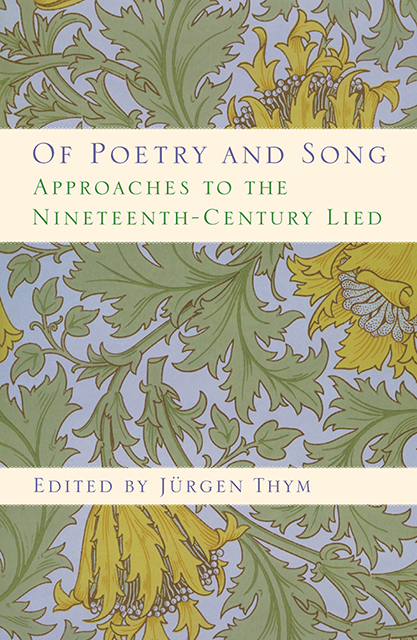Chapter One - On Schubert Reading Poetry: A Primer in the Rhythm of Poetry and Music
Published online by Cambridge University Press: 02 March 2023
Summary
I have long wanted to write a ruminative essay with a traditional but evocative title beginning “On … ,” and this collection of articles has given me the opportunity to do so by converting an old lecture into written form. In it I explore some basic relations between words and music, taking for illustration the Lieder of Franz Schubert. But inasmuch as an essay often begins with an epigram chosen from a source other than its subject, such as an apt quotation from a classical author, I shall provide as a motto an excerpt form Mozart’s song “Abendemp-findung an Laura,” K. 523 (example 1.1a). Just at the spot where our excerpt begins, the song, which is in F major, has moved to the dominant, C major (m. 23), and then turned to the parallel minor, where it cadences at the end of stanza 2 (m. 33). The music then modulates to G minor and cadences there at the end of stanza 3 (m. 46). But what is the music that seems to be “marking time” in measures 36–39, rocking back and forth melodically and harmonically between the V and flat VI of C minor? One could omit these measures without harm to the syntactical sense of the overall progression (example 1.1b).
To understand why the music “hovers” at this point, we need only look closely at the text. There we see that the verse, too, could do without the words that are sung in measures 36–39, for they constitute an embedded but separate thought—an independent, appositive clause inserted between dashes into the stanza’s primary clause:
Bald vielleicht—mir weht, wie Westwind leise,
Eine stille Ahnung zu—
Schließ’ ich dieses Lebens Pilgerreise,
Fliege in das Land der Ruh.
The main clause, the beginning of line 1 together with lines 3–4, reads, “Soon perhaps … I shall close this life’s pilgrimage, [and] fly into the land of peace.” The embedded, secondary clause says “a silent premonition wafts to me like a gentle westerly breeze.” The main clause expresses the speaker’s thought that his life may be near its end, and the appositive clause tells us how it felt when this presentiment came over him.
- Type
- Chapter
- Information
- Of Poetry and SongApproaches to the Nineteenth-Century Lied, pp. 3 - 36Publisher: Boydell & BrewerPrint publication year: 2010
- 1
- Cited by



